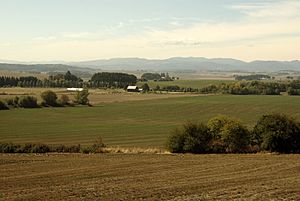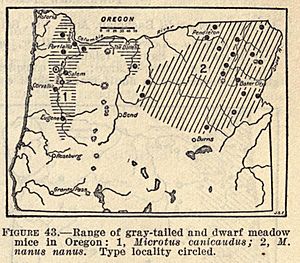Gray-tailed vole facts for kids
Quick facts for kids Gray-tailed vole |
|
|---|---|
| Conservation status | |
| Scientific classification | |
| Genus: |
Microtus
|
| Species: |
canicaudus
|
 |
|
| Distribution of the gray-tailed vole | |
The gray-tailed vole (Microtus canicaudus) is a small rodent. It's also called the gray-tailed meadow vole or gray-tailed meadow mouse. It belongs to a group of small rodents called Microtus. Voles are tiny mammals, and this one is about average size for a vole.
This vole lives only in the Willamette Valley in Oregon and Clark County, Washington. These areas are in the Pacific Northwest part of North America. Gray-tailed voles used to live in the grassy prairies of the Valley. Even though many of these areas are now farms, these animals are still common.
We don't fully understand why, but the number of voles in an area can change a lot. This can happen from season to season or year to year. Owls, hawks, and other meat-eating mammals hunt them. Fleas and ticks are also parasites that live on them. These voles dig burrows and complex tunnel systems. Sometimes, they even share these tunnels with other burrowing animals. We don't know much about their behavior in the wild. This is because they are shy and hard to catch in traps.
Contents
What's in a Name? (Taxonomy)
The scientific name for the gray-tailed vole is Microtus canicaudus. The first part, Microtus, comes from ancient Greek words. Mikros means "small," and ous means "ear." So, it means "small-eared." The second part, canicaudus, comes from Latin words. Canens means "gray," and cauda means "tail." So, canicaudus means "gray-tailed."
A scientist named Gerrit S. Miller first described the gray-tailed vole in 1897. The first official sample of the vole was found in McCoy, Oregon, in 1895. Scientists later studied this sample and eleven others to learn more about the species.
The gray-tailed vole is a single species, meaning it doesn't have different subspecies. It seems to be a close relative of the montane vole (Microtus montanus) or Townsend's vole (M. townsendii). For a while, some thought it was just a type of montane vole. But later lab tests showed they are two separate species. They live in different areas, but their ranges don't quite touch.
Appearance and Features
The gray-tailed vole is a small mammal. Its size is about average for a vole. Its fur on its back can be yellowish-brown or yellowish-gray. It has a short tail that is black or brown on top and grayish underneath.
Young voles have gray fur on their bellies. Their backs are a darker, "sooty" gray. Their feet are dark, and their tails are gray with a black stripe. They look similar to the montane vole. However, gray-tailed voles have yellower fur and a grayer tail.
The first vole sample measured about 135 mm (5.3 in) long from nose to tail tip. Its tail was about 33 mm (1.3 in) long. Its back foot was about 20 mm (0.79 in) long. Adult voles are usually about 141 mm (5.6 in) long. Their tails are about 35 mm (1.4 in). Their feet are about 20 mm (0.79 in), and their ears are about 12 mm (0.47 in). They have 16 teeth in total. This includes an upper and lower incisor on each side, and three upper and lower molars.
Gray-tailed voles live in the same areas as Townsend's vole (M. townsendii). Townsend's voles are darker and have longer tails. They also have slightly different skull structures. The gray-tailed vole also shares its home with the creeping vole (Microtus oregoni). The gray-tailed vole is built a bit stronger and has larger eyes. It also has some differences in its upper teeth.
Where They Live (Distribution and Habitat)
The gray-tailed vole lives only in the Willamette Valley, Oregon, and in Clark County, Washington. In Oregon, its range goes from Scappoose and Gresham in the north, down through the Willamette Valley to around Eugene. Some reports of them living east of the Cascades are now thought to be incorrect.
Gray-tailed voles are common in farm areas. You can find them in and around pastures, hayfields, and grain fields. They also live in areas where the land has been changed by humans. They used to live in the grassy prairies of the valley. Native Americans would burn these prairies every year. We don't know how this affected the vole populations.
The Willamette Valley gets about 40 in (100 cm) of rain each year, mostly in winter. The valley is warmer and drier than the hills around it. It has fewer forests and is better for farming.
Many other animals share this area with the gray-tailed vole. These include Roosevelt elk, Columbian black-tailed deer, Columbian white-tailed deer, and different types of rabbits and squirrels. Many birds also live here, like the sooty grouse and Steller's jay.
How They Live (Behavior)
Gray-tailed voles are rodents that dig burrows. They build complex networks of tunnels underground. They might also build nests above ground. These nests are often hidden under wood, old farm equipment, or other debris. They are even known to use tunnels dug by the Camas pocket gopher.
The tunnels give them shelter when it rains a lot, which happens often where they live. If the tunnels flood, the voles swim to dry spots or air pockets. If the whole tunnel system floods, they will go to higher ground. Sometimes, 20 to 30 voles have been seen gathered on dry fence posts in flooded areas. If someone came near, they would swim to a safer spot nearby. Where tunnels cross, they sometimes make special spots called middens. These are like small trash piles, about 8–15 cm (3.1–5.9 in) long and 3–5 cm (1.2–2.0 in) wide.
It's hard to catch gray-tailed voles alive in the wild. They usually don't go into traps that close them in. The best way to catch them is to place traps quietly along their usual paths. This way, the voles run right into them. Most of what we know about voles comes from watching them when they are kept in labs.
Life Cycle and Ecology
| Male | Female | |||
|---|---|---|---|---|
| Age (weeks) | Weight | Length | Weight | Length |
| 1 | 6.0 g (0.21 oz) | 68.7 mm (2.70 in) | 5.5 g (0.19 oz) | 66 mm (2.6 in) |
| 2 | 11 g (0.39 oz) | 97.5 mm (3.84 in) | 10.3 g (0.36 oz) | 92.2 mm (3.63 in) |
| 3 | 16.5 g (0.58 oz) | 117 mm (4.6 in) | 15.2 g (0.54 oz) | 114.8 mm (4.52 in) |
| 4 | 21.0 g (0.74 oz) | 129.5 mm (5.10 in) | 19.3 g (0.68 oz) | 24 mm (0.94 in) |
| 5 | 24.6 g (0.87 oz) | 136.9 mm (5.39 in) | 21.3 g (0.75 oz) | 129 mm (5.1 in) |
| 6 | 26.1 g (0.92 oz) | 140.9 mm (5.55 in) | 22.2 g (0.78 oz) | 131.1 mm (5.16 in) |
| 7 | 27.6 g (0.97 oz) | 144.8 mm (5.70 in) | 22.1 g (0.78 oz) | 132.6 mm (5.22 in) |
| 8 | 28.8 g (1.02 oz) | 146.9 mm (5.78 in) | 22.8 g (0.80 oz) | 134.3 mm (5.29 in) |
Most of what we know about how gray-tailed voles reproduce comes from studies in labs. Female voles can start having babies when they are as young as 18 days old. At this age, they weigh only about 12.5 g (0.44 oz). Younger mothers tend to have more babies in a litter. However, these babies are smaller and less likely to survive.
The babies grow inside the mother for 21 to 23 days. Newborn voles weigh about 2.5 g (0.088 oz). On average, a mother has about 4 or 5 babies in each litter. We are not sure how often gray-tailed voles breed in the wild. They probably breed all year round.
Gray-tailed voles can tell who their relatives are based on how familiar they are with them. In lab studies, voles that knew each other had fewer litters than those that didn't. Also, when related voles had babies, fewer of the babies survived.
In the wild, gray-tailed voles are thought to eat grasses, clover, wild onion, and false dandelion. Some sources say they eat both plants and meat, but there isn't clear proof for this.
Even though gray-tailed voles are common now, they used to be quite rare. Their numbers can change a lot throughout the year. It's hard to count how many voles live in an area in the wild. But in controlled studies, there might be around 600 voles per 1 hectare (2.5 acres).
Voles and People (Human Interactions)
Gray-tailed voles have been used in science experiments. Scientists have studied how not having enough minerals, like selenium, affects them. Selenium is a mineral that is often missing from the soil in the Willamette Valley.
They have also been used to study changes to animal feed. This includes treating feed by fermenting it or sprouting grains. Scientists also used them to see how quickly radioactive materials leave their bodies after eating contaminated food.
Sometimes, gray-tailed voles can become very numerous in their home areas. When this happens, people might try to control their populations. But, as mentioned, catching them can be quite tricky!
Conservation Status
The IUCN (a big group that studies nature) lists the gray-tailed vole as "least concern". This means they are not worried about this species disappearing. There are no big threats to this common animal. Even though they live in a small area (less than 20,000 square kilometers), they do well in farm environments. So, turning land into farms is not a problem for them. This species is also listed as secure by NatureServe, another conservation group.
Footnotes:
Sources:
- Musser, G.G.; Carleton, M.D. (2005). "Superfamily Muroidea". In Wilson, D.E.; Reeder, D.M. Mammal Species of the World: A Taxonomic and Geographic Reference (3rd ed.). Johns Hopkins University Press. p. 994. ISBN 978-0-8018-8221-0. OCLC 62265494. http://www.departments.bucknell.edu/biology/resources/msw3/browse.asp?id=13000254.
See also
 In Spanish: Microtus canicaudus para niños
In Spanish: Microtus canicaudus para niños





